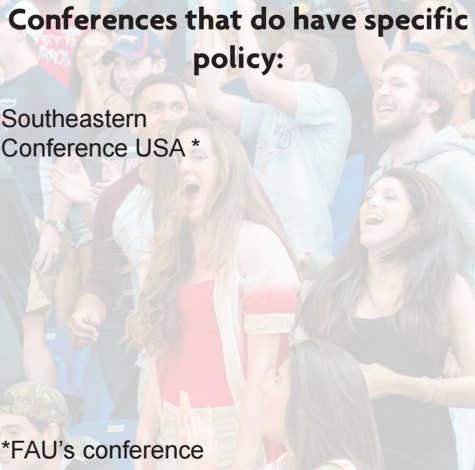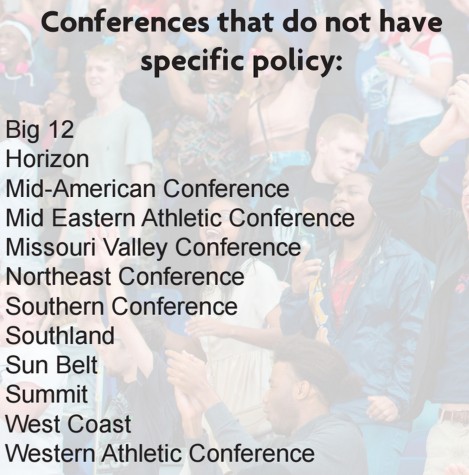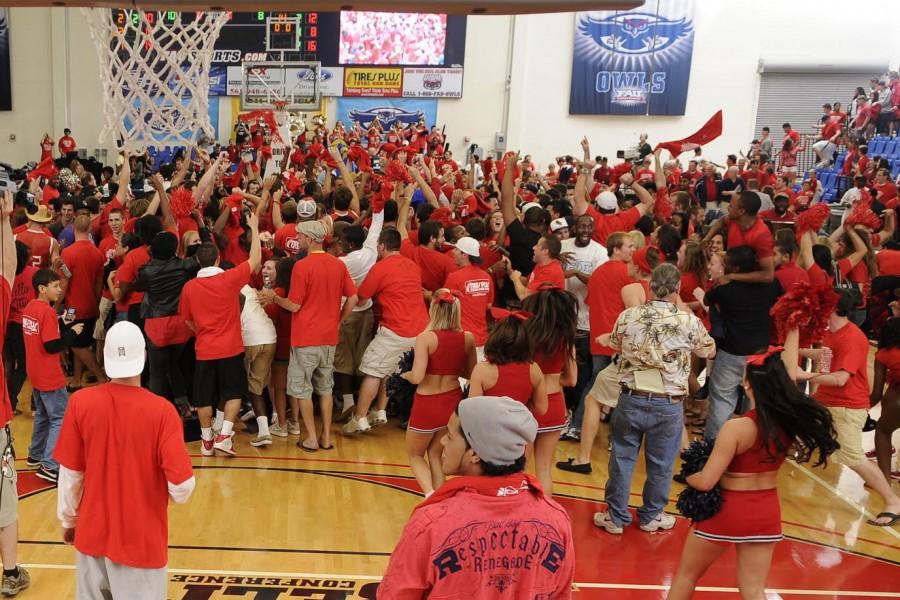Storm Chasers: Conference USA rules discourage fan invasion
Conference rules give penalties to schools, students involved in “court storming”
Students rush the floor in celebration after senior forward Brett Royster made the winning basket against FIU 2011. Photo courtesy of Owlpix.com
April 16, 2015
Florida International then-senior guard Phil Gary held the ball at the free throw line, his team holding a 72-71 lead over Florida Atlantic. If he hit both his free throws, FAU’s only shot to continue the game would be to hit a late 3-pointer. Gary missed both shots, allowing sophomore guard Greg Gantt to rebound. The Owls had a chance to win.
In the window of eight seconds, Gantt passed to junior guard Alex Tucker, who drove the length of the court to pass to senior forward Brett Royster, who hit a layup with four seconds remaining. FIU tried to hit a full court shot with the time remaining and missed, giving FAU a 73-72 come from behind victory. Students ran onto the court, swarming Owls players at center court in a sea of excited people.
Gantt remembers the moment fondly. “I remember it like it was yesterday, everyone was on the court.” he recalled. “I jumped on the media table and started yelling to our fans, It was great. We had so much fan support back then, it was my funnest (sic) year at FAU. The court storming never got old.”
This action taken by the FAU fans on the night of Feb. 5, 2011, known as “storming the court” has been a staple of fan celebration in college basketball throughout the history of the game.
Students across the nation swarm after a huge upset victory (win over a heavily favored opponents) or a last second shot. They’ve often created several of the largest moments in the sport’s history, including during last year’s semifinal in the 2014 NCAA Final Four, where a buzzer-beating shot by then-senior Shabazz Napier caused the University of Connecticut fans to celebrate moving on to the final by spilling out from the stands.
But on Feb. 24, when Kansas State University fans rushed the court after an upset at home, storming the court transitioned from a moment of fanship to an issue of safety. The fans streaming onto the court banged into Kansas players and pinned head coach Bill Self against a media table in the crush of bodies.
“I wasn’t nervous for me,” Self said in an interview with the Topeka Capital Journal after the game. “There were several students that hit our players — not saying like with fists, but when you storm the court, you run in, you bump everybody, stuff like that. This has got to stop.”
And now, more divisions are starting to say the same.
Conferences such as the Southeastern Conference and Conference USA, are starting to look at fines and punishments for students storming the court.
While Self’s team plays in the Big 12, a conference that doesn’t discipline teams for this kind of fan behavior, FAU plays in Conference USA, who do. The Owls previously played in the Sun Belt, who don’t have any rules in place for court invasions, but switched over to C-USA in 2013.
In the conference bylaws under the Competitive Environment section, schools are fined in ascending fashion for each offence in a five year period, from $10,000 for the first occurrence to as much as $30,000 for the third time and following occurrences within the cycle. Hosting teams may also be forced to forfeit the game if the fans are unable to be controlled and cause serious problems.
FAU also has it’s own code of conduct for game day behavior regarding students. Students who are not properly credentialed and enter the field of play face penalties including ejection from the event, arrest and possible prosecution by state and federal law, possible loss of ticket privileges and a student conduct case put against them.
But the risk of punishment doesn’t deter all students. “You could have problems with mobs,” said 24-year-old civil engineering student Ryan Bays. “But I would do it if I knew it was in good fun.”
Another student, 22-year-old exercise science major Donovan Washington seemed to light up at the thought of the possibility. “Yeah, I’d be down do it,” Washington said. “As long as they don’t take the win away from the team or throw me in jail.”
The University Press reached out to all 32 athletic conferences in NCAA Division 1 with college basketball. Two (C-USA and SEC) said they had policies and fines specifically for court storming. Twelve others did not have any policies or penalties specifically in their bylaws. (The other 18 conferences did not respond to requests for comment as of publication time.)
While the 12 schools did not have any specific laws against it and spoke of having very little problems in the past with this tradition, most cited that facility security and the hosting university are responsible for player and spectator safety, and that in most cases a commissioner is allowed to issue fines and punishments if an incident is severe enough.
“The Southern Conference currently does not have a policy concerning storming the court, nor do we have any penalties in place.” said the Commissioner of the Southland Conference John Lamarino. “This has only been an issue in the championship game of our tournament, which is likely why we’ve had no policy.”
Besides basketball, students storm at college football games under the same conditions, but at a greater scale. Fans often spill out mostly from the student section, and run straight for the field and goalposts, which can cause financial damage.
Last season, fans at the University of Mississippi tore down goal posts and took them out of the stadium after their 23-17 victory over the University of Alabama on Oct. 4, 2014. One goal post was brought to and left at “The Grove,” while the other was brought to an off-campus apartment a few blocks away.
Both posts were later recovered and cut apart to be sold to fans to pay the $75,000 needed to pay for new posts and a $50,000 SEC fine. The fans raised the money in a matter of four hours.
According to SBNation and Everythingtrackandfield.com, the average college goalpost (made of aluminum) cost anywhere between $5,000 and $18,000. According to Assistant AD for Media Relations Karina McCormack, FAU’s goalposts cost $12,000 for the set. Looking at the prices, that can be up to $36,000 worth of damage, a large amount of money for something that happens in a matter of seconds.
Despite fines, penalties and the risk of bodily harm, there seem to be very few things preventing fans from charging onto the court or field. At FAU’s football and basketball games, University Police and Contemporary Service Company (a contracted security company) gather at the end zones and on the sidelines at the end of the game to deter any field invaders from jumping the fences.
While not every conference will create policies, some schools are beginning to take notice of the risks. “We anticipate discussing this with our athletic directors in the spring.” said Lamarino.
FAU Athletic Director Patrick Chun could not be reached for comment as of publication
Time will tell if tradition will be ceased in favor of safety measures.








